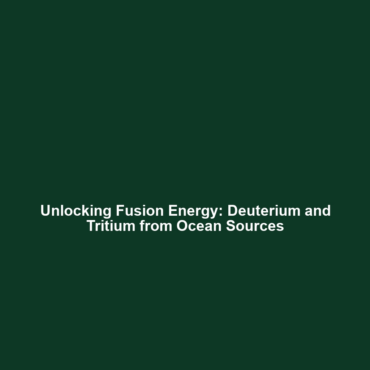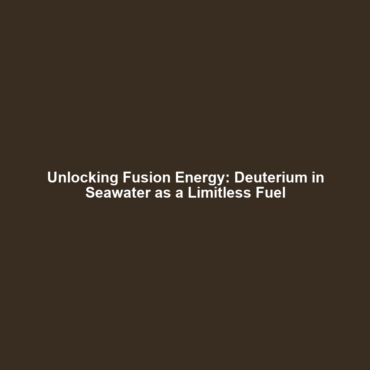Understanding Deuterium: The Key Ingredient in Fusion Energy
Introduction
Deuterium, a stable isotope of hydrogen, has gained significant attention within the realm of fusion energy. Its unique atomic structure, containing one proton and one neutron, positions it as a prime fuel source for nuclear fusion reactions. As the global energy crisis intensifies, the role of deuterium in achieving sustainable and clean energy solutions through fusion becomes increasingly relevant. In this article, we delve into the critical aspects of deuterium and its significance in advancing fusion energy technologies.
Key Concepts
Understanding Deuterium
Deuterium is one of the two stable isotopes of hydrogen, with an atomic mass approximately twice that of its more common counterpart, protium. In the context of fusion energy, deuterium’s dual-neutron structure allows for more robust fusion reactions, primarily the deuterium-deuterium (D-D) and deuterium-tritium (D-T) processes. These reactions release a significant amount of energy, propelling deuterium to the forefront of clean energy possibilities.
The Role of Deuterium in Fusion
Within fusion energy frameworks, deuterium can react with tritium to produce helium and a neutron, releasing approximately 17.6 MeV of energy. This energy output presents a compelling case for the practical application of deuterium in harnessing fusion energy as a sustainable alternative to fossil fuels.
Applications and Real-World Uses
The applications of deuterium in fusion energy span several domains, illustrating its versatility and importance:
- Fuel for nuclear fusion reactors: Deuterium is often used as a primary fuel in experimental reactors, pushing the boundaries of energy production.
- Hydrogen production: Deuterium can play a significant role in the hydrogen economy, providing a clean source of energy.
- Medical applications: Deuterium-labeled compounds are utilized in advanced medical imaging and biochemical research.
Current Challenges
Despite its potential, there are several challenges of deuterium in the context of fusion energy:
- Cost of extraction: Obtaining deuterium from natural sources, primarily seawater, can be expensive.
- Handling and storage: Deuterium’s storage and handling require advanced techniques due to its isotopic nature.
- Reactor design limitations: Current fusion reactor technologies face significant engineering constraints to achieve optimal deuterium fusion reactions.
Future Research and Innovations
Looking ahead, researchers are exploring innovative methods to enhance the efficiency of deuterium-based fusion reactions. Potential breakthroughs in plasma confinement techniques and advanced reactor designs hold promise for revolutionizing fusion energy development. Next-generation technologies focusing on deuterium extraction and utilization may pave the way for cleaner and more efficient energy sources.
Conclusion
In summary, deuterium stands as a cornerstone in the pursuit of fusion energy, showing significant promise for a sustainable future. Understanding its properties, applications, and the hurdles we face is crucial for advancing this vital energy source. For more insights on clean energy technologies, explore our articles on nuclear fusion developments and sustainable energy solutions.





